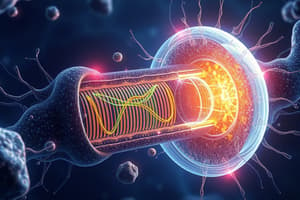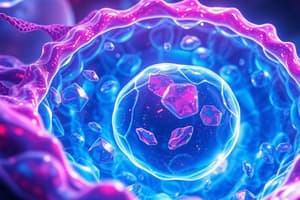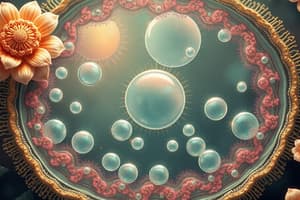Podcast
Questions and Answers
Which of the following is NOT an example of an anabolic reaction?
Which of the following is NOT an example of an anabolic reaction?
- Protein synthesis
- Breakdown of glucose through glycolysis (correct)
- DNA replication
- Formation of polysaccharides
What is the primary function of the nucleolus?
What is the primary function of the nucleolus?
- Regulating cell division
- Synthesizing ribosomes (correct)
- Producing proteins
- Storing genetic information
Which functional group is known for its role in energy storage and cell signaling?
Which functional group is known for its role in energy storage and cell signaling?
- Methyl (-CH3)
- Hydroxyl (-OH)
- Phosphate (-PO4) (correct)
- Carboxyl (-COOH)
What is the difference between oxidation and reduction in redox reactions?
What is the difference between oxidation and reduction in redox reactions?
Which functional group is responsible for the acidic properties of carboxyl groups?
Which functional group is responsible for the acidic properties of carboxyl groups?
Which of the following molecules is transported across the cell membrane through facilitated diffusion?
Which of the following molecules is transported across the cell membrane through facilitated diffusion?
Which type of metabolic reaction involves breaking down complex molecules into simpler ones?
Which type of metabolic reaction involves breaking down complex molecules into simpler ones?
What is the role of the nucleolar organizers in ribosome synthesis?
What is the role of the nucleolar organizers in ribosome synthesis?
Which of the following is NOT a characteristic of active transport?
Which of the following is NOT a characteristic of active transport?
Hydrolysis reactions primarily involve the ______ of chemical bonds.
Hydrolysis reactions primarily involve the ______ of chemical bonds.
Why is the cell membrane described as selectively permeable?
Why is the cell membrane described as selectively permeable?
Which type of transport requires the use of membrane channels?
Which type of transport requires the use of membrane channels?
Which functional group is involved in the formation of proteins and nucleic acids?
Which functional group is involved in the formation of proteins and nucleic acids?
What is the primary function of phosphorylation reactions?
What is the primary function of phosphorylation reactions?
Which of these processes involves the engulfment of solid particles?
Which of these processes involves the engulfment of solid particles?
Which of the following describes the movement of water from an area of high water concentration to an area of low water concentration across a semipermeable membrane?
Which of the following describes the movement of water from an area of high water concentration to an area of low water concentration across a semipermeable membrane?
How is the electrical potential difference of a nerve cell maintained?
How is the electrical potential difference of a nerve cell maintained?
Which of the following molecules uses receptor-mediated endocytosis for transport into the cell?
Which of the following molecules uses receptor-mediated endocytosis for transport into the cell?
What is the purpose of exocytosis?
What is the purpose of exocytosis?
In which solution would a cell swell and potentially burst?
In which solution would a cell swell and potentially burst?
Which of the following is NOT a function of protein carriers in the cell membrane?
Which of the following is NOT a function of protein carriers in the cell membrane?
What is the primary component of the cytoplasm?
What is the primary component of the cytoplasm?
Which of these is an example of a polar molecule that cannot passively diffuse across the cell membrane?
Which of these is an example of a polar molecule that cannot passively diffuse across the cell membrane?
Which type of endocytosis is responsible for the uptake of cholesterol into cells?
Which type of endocytosis is responsible for the uptake of cholesterol into cells?
What is the primary difference between facilitated diffusion and active transport?
What is the primary difference between facilitated diffusion and active transport?
What is the primary function of the plasma membrane?
What is the primary function of the plasma membrane?
Which statement accurately describes prokaryotic cells?
Which statement accurately describes prokaryotic cells?
How do phospholipids arrange themselves in the plasma membrane?
How do phospholipids arrange themselves in the plasma membrane?
What is one of the roles of membrane proteins?
What is one of the roles of membrane proteins?
What happens to the cell membrane fluidity when cholesterol levels increase?
What happens to the cell membrane fluidity when cholesterol levels increase?
In what way does facilitated transport differ from passive transport?
In what way does facilitated transport differ from passive transport?
What characteristic defines eukaryotic cells as opposed to prokaryotic cells?
What characteristic defines eukaryotic cells as opposed to prokaryotic cells?
What is the term used for the contents of a cell?
What is the term used for the contents of a cell?
Which of the following is NOT a primary function of the cytoskeleton?
Which of the following is NOT a primary function of the cytoskeleton?
What is the primary function of the peroxisome?
What is the primary function of the peroxisome?
Which of the following structures is directly involved in the synthesis of proteins?
Which of the following structures is directly involved in the synthesis of proteins?
Which organelle is responsible for packaging and modifying materials for export from the cell?
Which organelle is responsible for packaging and modifying materials for export from the cell?
Which type of endoplasmic reticulum is involved in the synthesis of proteins destined for secretion?
Which type of endoplasmic reticulum is involved in the synthesis of proteins destined for secretion?
Which of the following is a characteristic of the inner membrane of the mitochondria?
Which of the following is a characteristic of the inner membrane of the mitochondria?
Which type of cytoskeletal filament is responsible for providing mechanical strength beneath the plasma membrane?
Which type of cytoskeletal filament is responsible for providing mechanical strength beneath the plasma membrane?
What is the main role of the nuclear envelope?
What is the main role of the nuclear envelope?
Which of the following is NOT a function of the Golgi complex?
Which of the following is NOT a function of the Golgi complex?
What is the role of the nucleolus in the nucleus?
What is the role of the nucleolus in the nucleus?
Which of the following is a characteristic of microtubules?
Which of the following is a characteristic of microtubules?
Which organelle's function involves the breakdown of excess fatty acids?
Which organelle's function involves the breakdown of excess fatty acids?
What is the primary difference between rough endoplasmic reticulum and smooth endoplasmic reticulum?
What is the primary difference between rough endoplasmic reticulum and smooth endoplasmic reticulum?
What process is responsible for moving organelles along microtubule tracks?
What process is responsible for moving organelles along microtubule tracks?
Flashcards
What is the nucleolus?
What is the nucleolus?
The part of the nucleus responsible for synthesis of ribosomes, essential components for protein synthesis in the cytoplasm.
What are nucleolar organizers?
What are nucleolar organizers?
These are regions on chromosomes containing multiple copies of genes crucial for ribosome synthesis.
What are anabolic reactions?
What are anabolic reactions?
Metabolic reactions that build complex molecules from simpler ones, requiring energy.
What are catabolic reactions?
What are catabolic reactions?
Signup and view all the flashcards
What are oxidation-reduction reactions?
What are oxidation-reduction reactions?
Signup and view all the flashcards
What are hydrolysis reactions?
What are hydrolysis reactions?
Signup and view all the flashcards
What is phosphorylation?
What is phosphorylation?
Signup and view all the flashcards
What is dephosphorylation?
What is dephosphorylation?
Signup and view all the flashcards
What are functional groups in biomolecules?
What are functional groups in biomolecules?
Signup and view all the flashcards
What are hydroxyl groups?
What are hydroxyl groups?
Signup and view all the flashcards
Osmosis
Osmosis
Signup and view all the flashcards
Diffusion
Diffusion
Signup and view all the flashcards
Hypotonic Solution
Hypotonic Solution
Signup and view all the flashcards
Hypertonic Solution
Hypertonic Solution
Signup and view all the flashcards
Isotonic Solution
Isotonic Solution
Signup and view all the flashcards
Facilitated Diffusion
Facilitated Diffusion
Signup and view all the flashcards
Active Transport
Active Transport
Signup and view all the flashcards
Channel-mediated Diffusion
Channel-mediated Diffusion
Signup and view all the flashcards
Carrier-mediated Diffusion
Carrier-mediated Diffusion
Signup and view all the flashcards
Exocytosis
Exocytosis
Signup and view all the flashcards
Endocytosis
Endocytosis
Signup and view all the flashcards
Phagocytosis
Phagocytosis
Signup and view all the flashcards
Pinocytosis
Pinocytosis
Signup and view all the flashcards
Carrier-mediated Endocytosis (CME)
Carrier-mediated Endocytosis (CME)
Signup and view all the flashcards
Cytoplasm
Cytoplasm
Signup and view all the flashcards
Endoplasmic Reticulum
Endoplasmic Reticulum
Signup and view all the flashcards
Fatty Acid Breakdown
Fatty Acid Breakdown
Signup and view all the flashcards
Ribosomes
Ribosomes
Signup and view all the flashcards
Nuclear Envelope
Nuclear Envelope
Signup and view all the flashcards
Mitochondria
Mitochondria
Signup and view all the flashcards
Lysosomes
Lysosomes
Signup and view all the flashcards
Peroxisomes
Peroxisomes
Signup and view all the flashcards
Hydrogen Peroxide Breakdown
Hydrogen Peroxide Breakdown
Signup and view all the flashcards
Cytoskeleton
Cytoskeleton
Signup and view all the flashcards
Actin filaments
Actin filaments
Signup and view all the flashcards
Microtubules
Microtubules
Signup and view all the flashcards
Nuclear lamina
Nuclear lamina
Signup and view all the flashcards
Nucleolus
Nucleolus
Signup and view all the flashcards
Chromosomes
Chromosomes
Signup and view all the flashcards
Cell
Cell
Signup and view all the flashcards
Unicellular
Unicellular
Signup and view all the flashcards
Multicellular
Multicellular
Signup and view all the flashcards
Prokaryotic Cells
Prokaryotic Cells
Signup and view all the flashcards
Eukaryotic Cells
Eukaryotic Cells
Signup and view all the flashcards
Plasma Membrane
Plasma Membrane
Signup and view all the flashcards
Protoplasm
Protoplasm
Signup and view all the flashcards
Phospholipid
Phospholipid
Signup and view all the flashcards
Study Notes
Cellular Basis of Life
- Cells are the basic units of structure and function in living organisms, which can be unicellular (single cell) or multicellular (multiple cells).
- Cells are categorized as prokaryotic (bacteria, no membrane-bound nucleus or organelles) or eukaryotic (all other organisms, with a membrane-bound nucleus and organelles).
- This module focuses on animal cells.
The Cell: Parts and Functions
- Cells are small, microscopic entities enclosed by a cell membrane.
- Protoplasm is the internal contents of a cell.
- Plasma membrane acts as a barrier and gateway, regulating substance exchange with the external environment.
- It also enables cell communication.
- The membrane's structure is a phospholipid bilayer with hydrophobic tails facing inward and hydrophilic heads outward.
- Membrane proteins facilitate transport, cell recognition, and communication.
- Cholesterol maintains membrane fluidity.
Transport System in Cell Membrane
- Cell membranes are selectively permeable.
- Passive transport:
- Diffusion: Movement of molecules from high to low concentration until equilibrium. Examples include oxygen and carbon dioxide.
- Osmosis: Movement of water across a semipermeable membrane from a low solute concentration to a high one. Hypotonic solutions have lower solute concentration than the cell, causing water influx. Hypertonic solutions have higher solute concentration than the cell, causing water outflow. Isotonic solutions have equal solute concentration, resulting in no net water movement.
- Active transport: Uses energy (ATP) to move substances against their concentration gradient, concentrating molecules within the cell.
- Facilitated diffusion: Movement of molecules through protein channels or carriers with no energy expenditure.
- Membrane transport mechanisms include endocytosis (taking in large molecules) and exocytosis (releasing large molecules). Types of endocytosis include phagocytosis (taking in solids), pinocytosis (taking in fluids), and receptor-mediated endocytosis (specific molecule uptake).
Protoplasm: Cytoplasm
- Cytoplasm: The cell's internal contents excluding the nucleus. Contains water, enzymes, and nutrients.
- Cellular Structures and Organelles:
- Ribosomes: Protein synthesis. Free in cytoplasm or bound to rough ER.
- Endoplasmic Reticulum (ER): Network of membranes. Smooth ER lacks ribosomes, rough ER has ribosomes.
- Golgi Complex: Modifies, stores, and packages proteins and lipids for secretion.
- Lysosomes: Contain digestive enzymes to break down cellular waste and debris.
- Peroxisomes: Breakdown fatty acids and hydrogen peroxide, and participate in other metabolic processes.
- Mitochondria: Cellular respiration, produce ATP. Have an inner membrane folded into cristae and an outer membrane. Have their own DNA.
- Cytoskeleton: Provides structural support, intracellular transport, movement. Composed of actin filaments, intermediate filaments, and microtubules.
Nucleus
- Encloses the cell's genetic material (DNA).
- Nuclear envelope: Double membrane with pores regulating nuclear-cytoplasmic exchange.
- Chromosomes: DNA organized into chromosomes during cell division.
- Nucleolus: Ribosome production site.
Metabolic Reactions
- Metabolism encompasses all biochemical processes.
- Anabolism: Synthesis of complex molecules from simpler ones (requires energy).
- Catabolism: Breakdown of complex molecules into simpler ones (releases energy).
- Oxidation-reduction (redox) reactions: Electron transfer between molecules.
- Hydrolysis reactions: Breakdown of bonds using water.
- Phosphorylation/dephosphorylation: Addition/removal of phosphate groups for regulation.
Functional Groups in Biomolecules
- Functional groups are specific arrangements of atoms conferring unique properties to biomolecules. Examples include hydroxyl (-OH), carbonyl (C=O), carboxyl (-COOH), amino (-NH2), phosphate (-PO4), sulfhydryl (-SH), methyl (-CH3), amide (CONH2), and ester groups.
Studying That Suits You
Use AI to generate personalized quizzes and flashcards to suit your learning preferences.




